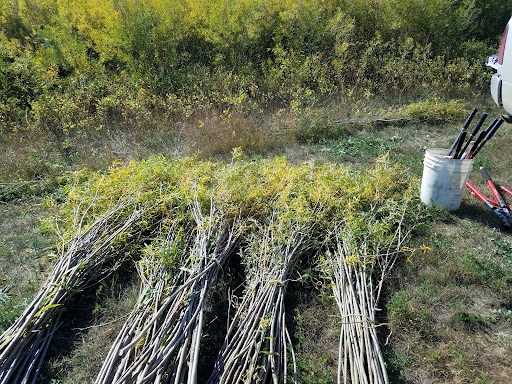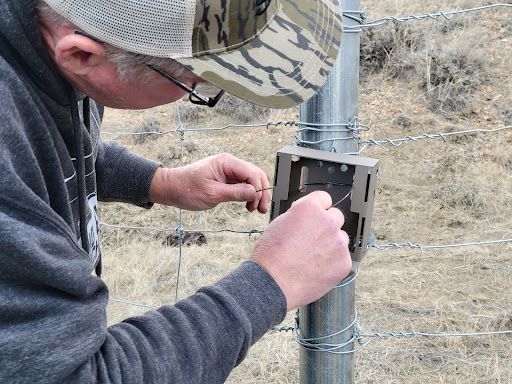October was filled with a few fieldwork projects and lots of movement across Eastern Montana. The prairie is absolutely gorgeous this time of year! We’re feeling grateful to be able to get out, visit with folks in the field, and support organizations such as The Nature Conservancy and Montana Department of Transportation.
It’s one thing to talk about taking action, and it’s quite another thing to actually get out and act. This is the second installment of a monthly update from the field where you’ll be able to celebrate with MWF and track the places we’ve visited, folks we’ve supported and worked with, and our work in the field. Stay tuned for monthly updates from the field going forward!
Supporting Material Preparation with The Nature Conservancy (TNC) at Matador Ranch

MWF staff, Morgan Marks at TNC’s Matador Ranch; Photo taken by MWF staff, Morgan Marks.
Similar to the habitat restoration work that occurred this past August, TNC implemented low-tech stream restoration methods and MWF showed up to support the preparation of gathering materials at the Matador Ranch for a few hours on the way to visit Plentyville, Flaxville, and Scobey. Working directly with other conservation organizations that are innovating and trying new methods of conservation is truly exciting. It was a pleasure to meet TNC staff, work alongside them and other folks from organizations such as Montana Conservation Corps.


Pictured are materials (woody materials and willows) that were being gathered and prepared for low-tech stream restoration methods; Photo taken by MWF staff, Morgan Marks.
Visit to Flaxville, Plentywood and Scobey
Since coming onboard this past June, a big goal of Morgan’s has been to get out, go far, and get out and go far and often with the intention that relationship building and outreach happens best when people gather, are together, and take time to visit. Flaxville, Plentyville and Scobey aren’t nearby, since they’re north of the Hi-Line, but visiting folks in the furthest reaches of Montana is what MWF is working to do.
On this visit, Morgan met with a few staff from Montana Fish Wildlife and Parks (FWP), a staff person with Pheasants Forever, and an upland bird hunter who also serves on the Upland Game Bird Enhancement Program Advisory Council for FWP to learn more about the area, what folks care about, and how MWF can support. Feedback was that most people often overlook rural places, so MWF is humbled and proud that we’re shifting our focus to get out there and meet with folks in rural places.
Wildlife Xing: 2021 Educator Conference with National Wildlife Federation
MWF is working to support and help outreach about the Wildlife Xing program throughout Eastern Montana. MWF, an affiliate of National Wildlife Federation (NWF), tabled with NWF staff at the recently held 2021 Educator Conference in Great Falls. In an effort to improve both human and wildlife safety, NWF worked with partners to develop an 8-lesson curriculum for high school classrooms that can be paired with an app on a smartphone to track and report data about wildlife sightings. Right now, two schools have committed to piloting the new curriculum and MWF is supporting NWF with getting this awesome migration and connectivity curriculum into other high schools.
Know a high school teacher who may be interested? Contact Naomi at NWF so she can connect with them!
Montana Department of Transportation and Game Cameras

Larry Sickerson, a biologist by training and staff with Montana Department of Transportation is pictured installing a wildlife game camera; Photo taken by MWF staff, Morgan Marks.
MWF isn’t about choosing favorite fieldwork projects, but if we had to choose, this one would be one of our top picks! Because of that and because there’s a lot of information and photos to share, please stay tuned for a longer blog post about this fieldwork project with Montana Department of Transportation.
Montana Farmers Union 2021 Annual State Convention
MWF tabled at the Montana Farmers Union 2021 Annual State Convention and had some really fantastic conversations about wildlife and working lands. We’re working to not only advocate for wildlife but understand conflicts that exist and learn how we can support folks in the field. This venue was a great opportunity for MWF to show up and listen.
Community Pint Nights: Sidney and Glasgow
We’ve been very humbled to visit rural communities and have space to do so through tabling at breweries as an introduction to spaces MWF hasn’t yet been present in. Many thanks to Meadowlark Brewing and Busted Knuckle for their generosity and welcoming MWF to host a pint night and share in an evening of community and conversation!


Logos pictured are from Busted Knuckle Brewery in Glasgow and Meadowlark Brewing in Sidney.
Thanks very much for reading! Check out the MWF Facebook page for upcoming events and help us spread the word to your family and friends by forwarding our field updates to folks who may be interested in seeing what we’re up to!
For questions, suggestions about fieldwork opportunities, to get involved as a volunteer, and to share upcoming events you think would be great for MWF to show up at, please email or call Morgan at 406-403-4464 morgan@mtwf.org
See you in the field,
MWF Field Team


